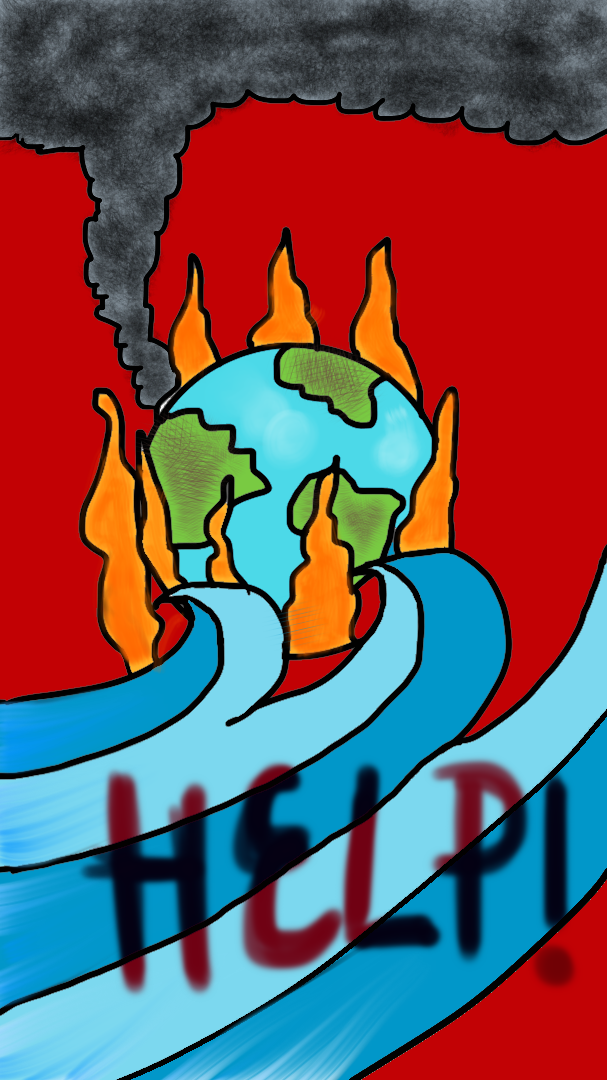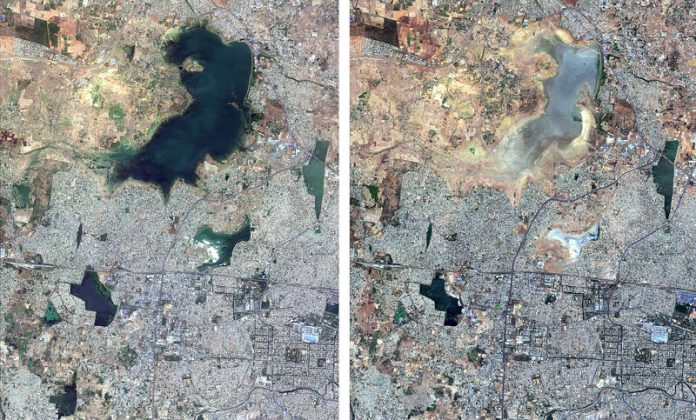This article is written by Iqra Khan, a second year law student of Jamia Millia Islamia..
Currently, the newspapers are all filled with the news of changing climate, global warming, forest fires, droughts, floods etc. We have studied about climate and global warming in our grade 8 science textbooks but now we can all witness it. This climate change is real and obviously the most important global issue of the era!
This is not all, India will be facing lot more damages due to climate change in the coming years. It is the time to declare climate emergency as called by the UN. The UK, Ireland, Canada and France have all declared climate emergencies. The Indian government should declare a climate emergency immediately. Immediate policy changes should include reducing the usage of fossil fuels by half by 2030, encouraging the use of public transport, increasing forest area, promoting non-conventional energy, devising good water management policies, implementing the plastic ban stringently, banning the burning of waste, promoting innovative urban planning policies and reducing mass rearing of cattle for human consumption.
There hasn’t been any formal study made by Indian committees regarding the effects of climate change. N.H. Ravindranath, a climate scientist will lead the first national assessment of the impact of climate change in India. It is crucial to have scientific data so that the impact of climate change can be seen on various sectors of the country such as agriculture (which is assumed to be the most affected sector due to climate change), human health and productivity, tourism, economy, loss due to sea-level rise. According to a report by the UN, India has already incurred losses of USD 79.5 billion in the last 20 years.
Climate activist Greta Thunberg, in the UN’s Climate Action Summit in New York City on 23 September 2019, said that the popular idea of cutting our emissions in half in 10 years only gives us a 50% chance of staying below 1.5 degrees [Celsius], and the risk of setting off irreversible chain reactions beyond human control.
The environmental crisis that needs the most attention is “#ClimateChange”. I use the hashtag, due to the reason that, we the “millennials” are very fond of topics trending with this hashtag. So, let’s make this crisis trending too! Climate Change does not affect single or multiple nations but the whole human race. This international problem needs immediate addressal and solutions. Nations need to amend their laws so that there’s no more contribution of human activities in climate change. There’s a lot of evidence regarding the climate change which will be discussed in the blog. Regardless of numerous International laws and treaties, climate change does not seem to be in control. As a developing country, India needs to amend its law or make new laws for this crisis.

Table of Contents
What is Climate change?
Climate is the change in the atmosphere over a long period of time or in other words climate is the average weather condition of a particular place. The reason why studying climate and a changing climate is important, is that it will affect people around the world. Rising global temperatures are expected to raise sea levels, and change precipitation and other local climate conditions. Changing regional climate could alter forests, crop yields, and water supplies. It could also affect human health, animals, and many types of ecosystems. Deserts may expand into existing rangelands, and features of some of our National Parks and National Forests may be permanently altered. Climate change is a long-term change in the average weather patterns that have come to define Earth’s local, regional and global climates. These changes have a broad range of observed effects that are synonymous with the term.
Changes observed in Earth’s climate since the early 20th century are primarily driven by human activities, particularly fossil fuel burning, which increases heat-trapping greenhouse gas levels in Earth’s atmosphere, raising Earth’s average surface temperature. These human-produced temperature increases are commonly referred to as global warming.
When the greenhouse gases prevent the heat released from the earth to go into the space, the temperature of the planets rises. This rising of the temperature of the earth is what is known as green house effect. Human activities are considered the main factor for the rapid increase in climate change. According to the report of the Intergovernmental Panel on Climate Change (IPCC), Global warming has led to shifts of climate zones in many world regions, including expansion of arid climate zones and contraction of polar climate zones. As a consequence, many plant and animal species have experienced changes in their ranges, abundances, and shifts in their seasonal activities.All this because of a common threat of Climate change. Burning of oil, coal, fossil fuels, stubble burning (as in the northern parts of India which has increased the air pollution in the city of New Delhi, where the Air Quality Index has reached to a level of hazardous quality), burning of waste, smoke from the industries and vehicles, CFCs from air conditioners etc contributes to the climate change.
Is climate change for real? What is the cause?
While the US is busy denying the climate change and calling it a hoax, the scientists all over the world are confirming it. According to National Aeronautics and Space Administration (NASA), there are some compelling evidences that force us to believe that climate change is real such as Global Temperature Rise by about 1.62 degrees Fahrenheit since the 19th century, Warming of Oceans, rise in the sea level, shrinking of ice sheets, extreme rainfalls, droughts, forest fires, bleaching of coral reefs.
What’s the main cause for this climate change? It is evidently the human activities. According to the 5th Assessment Report of IPCC, which gives evidence that ocean have warmed, amount of snow and ice have diminished, sea level have risen and the concentration of greenhouse gases have increased. It concludes that human influence on climate change is clear.
Recent Issues
Forest fires in Amazon and Australia. Almost 30,000 sq. km of forest area had burnt in the forest fires of Amazon last year. The fire was extremely devastating on the other hand the forest fire in Australia was far more devastating than the Amazon. The land burned is almost twice the area that got destroyed in 2019’s Amazon Fires. More forest fires increases the global warming and the earth is getting warmer. Millions of animals, along with a few people have died in the fire of Australia, the photographs on social media are heart breaking. Temperatures in Australia have seen a new high due to these natural calamities. Forest fires is becoming a massive climate issue.
A quick history of the development on the International Climate Laws
1988
The World Meteorological Organization (WMO) and the UN Environment Programme (UNEP) formed the IPCC, and the assessments made by IPCC are the basis for the international negotiations. IPCC is a global organization, with self contributions of hundreds of scientists all over the globe these scientists then analyze the conditions and changes that takes place in the environment, climate or weather. They create analysis reports which in fact become the structure of policies or platform of negotiations in IPCC.
1990
IPCC released its first assessment report and called for the second World Climate Conference. The report said that GHGs concentrations were increasing due to human activities.
1994
United Nations Framework Convention on Climate Change (UNFCC) that was adopted in the year 1992 at UN came into force in 1994 after being open to countries for signature in Rio De Janeiro.
1995
Presided by Angela Merkel, environment minister of Germany, First Conference of Parties (COP1) was held in Berlin. It is also known as Berlin mandate.
1997
Kyoto Protocol, first GHGs emission reduction treaty was adopted.
2001
The seventh meeting of Conference of Parties held in 2001 and resulted in Marrakesh Accords.
2005
Finally, Kyoto Protocol came into force in this year.
2007
The thirteenth Conference of the Parties, in Bali adopted the Bali Road Map, which was a new plan for addressing climate change..
2009
World leaders gathered for the fifteenth Conference of the Parties in Copenhagen, which resulted in Copenhagen Accords.
2010
The sixteenth Conference of the Parties results in the Agreements. The Green Climate Fund, the Technology Mechanism and the Cancun Adaptation Framework were established in this year.
2011
At the seventeenth Conference of the Parties in Durban, governments committed to a new universal climate change agreement by 2015.
2012
At the eighteenth Conference of the Parties, governments agreed to work toward a universal climate change agreement by 2015 and adopted the Doha agreement.
2014
UN Secretary-General Ban Ki-moon hosted a summit in New York, inviting Heads of State and Governments to initiate action for climate change.
2015
Twenty-first Conference of Parties (COP 21) was held and the historical Paris Agreement was adopted. The Paris agreement brought the entire nation (195) for a common cause to fight climate change and move towards a low carbon future. Later US has had taken a step back from Paris Agreement.
2018
IPCC had confirmed a global warming of 1.5C.
2018
Governments adopted Katowice Climate Package. This is a pack of guidelines to implement the Paris agreement, it was held in Poland.
2019
The COP25 UN Climate Change summit was held in Chile, Madrid.
Assessment of India’s contribution to Climate Change
India’s climate can be classified as a hot tropical country, except the northern states of Himachal Pradesh and Jammu & Kashmir in the north and Sikkim in the northeastern hills, which have a cooler, more continental influenced climate.
India’s contribution to climate change is relatively low as compared to US and China.India saw emissions rise by 4.8%, or 105 Mt, with the growth split evenly between power and other sectors such as transport and industry.
In the most polluted cities across the world, India shares the maximum number of cities. Air pollution is one of the major issues faced by India currently. Either the reason may be air pollution by stubble burning or the fireworks, or be it by petrol or diesel cars, we have air pollution which is interlinked to climate change.
India’s Response to Climate Change
India is a signatory to both UNFCC and Kyoto Protocol, but they both do not make India meet specific targets in reducing emissions. But still India has been taking voluntary actions to suppress the GHGs emissions.
Ministry of Environment, Forest and Climate Change (MoEFCC) is the primary body at the central level that governs the work of planning, promoting and implementing policies relating to the environment, forests and climate change in the country. The ministry works with principle of sustainable development and well being of human.
The most significant plan is the National Action Plan on Climate Change, which came in 2008. Within which eight missions were described. To decentralize the NAPCC, the government issued an order for all states to submit their respective State Action Plans on Climate Change (SAPCC), which have now been prepared for almost all states and Union Territories across India, namely:
- National Solar Mission
- National Mission for Enhanced Energy Efficiency
- National Mission for Sustainable Habitat
- National Water Mission
- National Mission for Strategic Knowledge on Climate Change
- National Mission for Sustainable Agriculture
- National Mission for Green India
- National Mission for Sustaining the Himalayan Ecosystem
Many new initiatives were launched as part of these missions, during the year 2018- 19. These include; Centre of Excellence, at Divecha Centre for Climate Change, IISc, Bangalore and National Knowledge Network programmes one each on Urban Climate and Himalayan cryosphere; One Human Capacity Building Programme at National Institute of Disaster Management (NIDM), New Delhi; Three State Climate Change Cells one each in Gujarat, Bihar and Assam; 6 State Knowledge Network programmes in the Himalayan States of J&K, Himachal Pradesh, Assam, Arunachal Pradesh, Meghalaya and Manipur.
The steps that are taken by the government of our county are not too effective.When we look at the manifesto of our government for the year 2019. We hardly find the issue in the 15 topics mentioned by the government. Governments all over the world are treating this as a secondary issue. NAPCC, which has completed about ten year have set many goals to achieve, but not the appropriate method to handle the crisis in India. India as a low income country cannot combat the problem of climate change alone, even though policies are made but there is need of financial support, technological development and human resource for the proper implementation of the made policies. Also, the visions should be realistic, which are easy to accomplish.
But what can I do?
Any big change starts with individual efforts, we can create awareness among people, adopting activities and lifestyles that reduce the harm to the environment. Use more of public transport, switching to clean energy. Sensitize your local community about the issue. Ask the government or the authorities to take steps regarding this issue. Create pressure on the industries to reduce their emissions. While the heads of certain countries (you know who) are asking young “climate activists” to “chill”and not acting on it, we ‘the young climate advocates’ can attract the attention of the leaders towards this issue. And yes, never think that the change won’t take place because of only you.
Conclusion
When we see kids like Greta Thunberg we are filled with enthusiasm to do something about climate change because it is not for someone’s personal benefit but for the good and survival of all. How can we leave a planet that’s on the verge of dying for the future generation? It is our duty to make the wronged done, right. There have been negotiations going on, internationally and it is important for the countries to abide by those conventions and implement them domestically. Individually, we should try to reduce the consumption of non-renewable resources and move on to clean energy. Cutting of trees and then trying to sow millions of new seeds is not the solution, since mature trees that are cut, would take years to grow in place of the trees that have been cut down. There should be awareness programs at schools and colleges about the issue. At government offices, there should be sensitization programmes. But that too should not turn into a formal activity for everyone, therefore the real hazards need to be discussed.
Climate Issue has only become a political issue for many governments all over the world, a topic for vote bank. But governments do not realize this that this is the main issue for human kind. They should realize that there are billions of people who are prone to climate change and the under developed countries will face extreme difficulties in fighting such change.
This is only possible through united efforts of all governments of the world, all the people of the world. Awareness has to be made to people regarding the effects of climate change. But all these assessments, policies and conventions are useless until and unless we realize that it is our duty to do it. It is our duty to save the environment and the planet.
In the end, I would say that Greta Thunberg was correct in asking everyone, “How could you?”
Students of Lawsikho courses regularly produce writing assignments and work on practical exercises as a part of their coursework and develop themselves in real-life practical skill.
https://t.me/joinchat/J_0YrBa4IBSHdpuTfQO_sA
Follow us on Instagram and subscribe to our YouTube channel for more amazing legal content.
 Serato DJ Crack 2025Serato DJ PRO Crack
Serato DJ Crack 2025Serato DJ PRO Crack











 Allow notifications
Allow notifications



